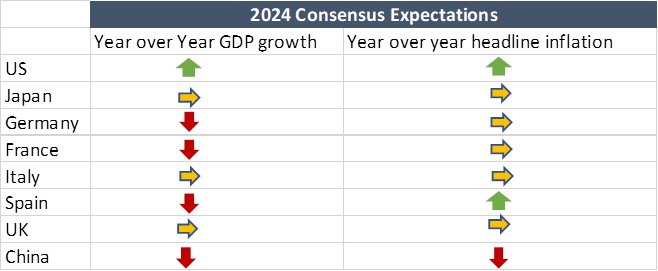Facts, figures and scenarios for the economies of the United States of America, China, Japan, Germany and France. Analysis by William Davies, Global Chief Investment Officer at Columbia Threadneedle Investments.
2023 provided better-than-expected economic data: inflation fell, employment held up well, and the risk of recession was averted, also thanks to resilient growth. In light of this positive scenario, the US Federal Reserve, along with other central banks, chose to keep interest rates higher for a longer period. Currently, the market is led by doubts about the timing of a potential interest rate cut and the extent of the economic slowdown. Here are our thoughts in light of 2024.
Geopolitical risks may outweigh economic risks
Although the economic slowdown has not yet occurred, we at Columbia Threadneedle believe that this will not have a significant negative impact. We know intimately the risks of a gradual increase or decrease in inflation, as well as the risks of a fairly deep recession.
However, we believe that the most significant threats in 2024 will be geopolitical in nature, given the short-term volatility and inflationary pressures they could generate in the long term. Companies will suffer the most, because identifying alternative energy supplies or developing new supply chains entails particularly high costs. Among the most important geopolitical risks are the escalation of the conflict in the Middle East and the escalation of tensions between the United States and China. In addition, there is the unknown related to the US elections, the impact of which on the markets cannot be predicted.
Opportunity in uncertainty
Looking into the new year, investors will need to find the right balance between optimism about the global economy and the many uncertainties surrounding it. When it comes to bonds, U.S. government bonds, medium- to long-term, and corporate bonds with investment-grade ratings are a good choice, because they offer strong rates of return. High-yield bonds, which yield close to 10%, are also an attractive option.
Obviously, investment choices will generally depend on expectations of economic performance and appetite for risk. When it comes to stocks, we think it’s useful to broaden our view beyond the small group of companies that have dominated the market in 2023. In fact, stock market performance should improve and areas that haven’t shown the gains made by stronger sectors can improve. . Offer interesting opportunities.
Return of differentiation in markets
During and in the aftermath of the Covid-19 pandemic, central banks and fiscal policies have pursued the same goal, albeit with different strategies: to stabilize economies. Over the course of 2023, we have seen a gradual differentiation in terms of policy benefits and economic outcomes; This discrepancy may become more apparent in 2024 (see Figure 1).

For example, the Fed can keep interest rates higher for longer than the Bank of England, given the structure of the English economy, which is characterized by shorter-term mortgage lending and generally greater exposure to rising interest rates. The eurozone managed to avoid a recession in 2023, thanks to a mild winter that allowed energy costs to be kept low despite the loss of Russian supplies. The same could happen in 2024 as well.
Moreover, the gaps between economies are also widening in terms of valuations. Currently, forward earnings are 18 times, making US stocks much more expensive than European (12 times) and Japanese (14 times) stocks. However, we believe that evaluation alone cannot justify a regional bet in the near future, although it is evidence of increasing differentiation between markets and in this sense could be a harbinger of new opportunities.
Longer time periods for energy transmission
In light of slowing economic growth, the implementation of energy transition programs may slow and some commitments may fail, as we have seen happen in the United Kingdom. While we affirm our readiness to honor the commitments made on this front, we must bear in mind that in a weaker economic context, it may be necessary to find the right balance between these efforts and other economic and budgetary priorities.
Bottom line: opportunity before slowdown
The state of the economy is currently characterized by moderate or slow growth, low inflation and high interest rates. Some believe a deeper recession is possible due to continued high interest rates, while others expect higher inflation linked to continued strengthening of the economy, production cuts by OPEC or even the impact of war. In our opinion, we believe that a moderate scenario is likely to occur over the next six months.

“Prone to fits of apathy. Introvert. Award-winning internet evangelist. Extreme beer expert.”



